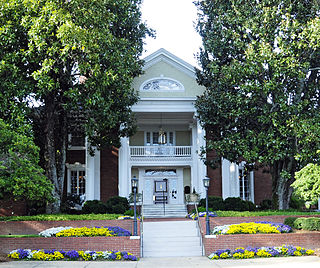
Pettigru Street Historic District is a historic tree-lined neighborhood east of Main Street in downtown Greenville, South Carolina. It is home to 88 structures built between 1890 and 1930 with the majority built between 1910 and 1930. It is known for its wide variety of architectural styles including Queen Anne, Colonial Revival, and Bungalow. The area is an example of evolution of architectural style from the Victorian era to the early 1930s similar to the growth in the city of Greenville as a whole during that time.
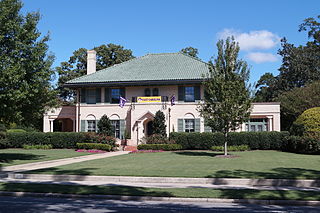
The College View Historic District is a national historic district located north of East Carolina University at Greenville, Pitt County, North Carolina. The district encompasses 343 contributing buildings in a predominantly residential section of Greenville. It includes buildings dated from about 1909 to World War II and notable examples of Bungalow / American Craftsman, Colonial Revival, and Tudor Revival architecture. Notable buildings include St. Paul's Episcopal Church (1930), the Rotary Club Building (1921), Chancellor's Residence, William Harrington House, Bateman House (1910), Franklin Vines Johnston House (1923), and Dr. Paul Fitzgerald House (1929).

East Main Street–Douglass Heights Historic District is a national historic district located at Union, Union County, South Carolina. The district encompasses 55 contributing buildings in a primarily residential section of Union. The houses were built between about 1823 to 1940, and are in a variety of popular architectural styles include Neo-Classical, Queen Anne, and Colonial Revival. Notable dwellings include the Steadman-Nicholson House, Laurens G. Young House, and William H. Wallace House. Located in the district is the separately listed Union High School-Main Street Grammar School.

South Street–South Church Street Historic District is a national historic district located at Union, Union County, South Carolina. The district encompasses 78 contributing buildings in a primarily residential section of Union. The houses were built between about 1850 to about 1930, with the majority dating from about 1850 to about 1915. The district includes many large-frame Queen Anne inspired houses built about 1880–1910. Also in the district are Neo-Classical, Gothic Revival, Colonial Revival, Tudor Revival, American Foursquare, and Bungalow style dwellings. The district includes the first Carnegie Library established in South Carolina.

Greenville County Courthouse, also known as Greenville Family Courts Building, is a historic courthouse located at Greenville, South Carolina. It was built in 1918, and is a Beaux-Arts style brick and concrete building with terra cotta trim. The building consists of a three-story front section, with an eight-story tower behind. The building served as the courthouse for Greenville County until 1950 when the court was moved to a new building. The Family Court of Greenville County was located then in the building and remained there until 1991.
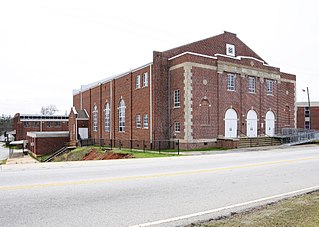
Parker High School Auditorium is a historic high school auditorium located at Greenville, South Carolina. It was built in 1938 with funding provided by the Works Progress Administration. It is a Classical Revival style 7500 square foot rectangular brick building with a front gabled roof. It is the last remaining building from the largest WPA school project in South Carolina.
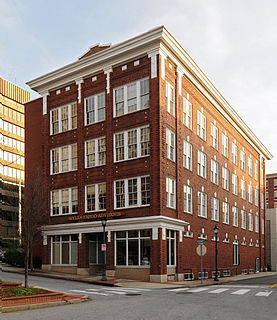
Carolina Supply Company is a historic commercial building located at Greenville, South Carolina. It was built in 1914, and is a four-story, brick building in a utilitarian Renaissance Revival style. The building housed a textile and industrial supply company that supplied mills with equipment and supplies. The building now houses Wells Fargo Bank.

Hampton–Pinckney Historic District is a national historic district located at Greenville, South Carolina. It encompasses 70 contributing buildings in a residential section of Greenville. The houses date from about 1890 to 1930, and include Italianate, Greek Revival, Queen Anne, various bungalows, and examples of Gothic Revival and Colonial Revival design, as well as vernacular forms. The oldest house in the district is the McBee House.

Col. Elias Earle Historic District is a national historic district located at Greenville, South Carolina. It encompasses 74 contributing buildings in a middle-class neighborhood of Greenville. The houses primarily date from about 1915 to 1930, and include Neoclassical, Colonial Revival, Tudor Revival, and bungalow styles. The district was originally part of the estate of Colonel Elias Earle, a prominent early-19th century Greenville citizen. The Earle St. Baptist Church is located in the district.

West End Commercial Historic District is a national historic district located at Greenville, South Carolina. It encompasses 15 contributing buildings in Greenville's second "downtown." The commercial buildings primarily date from about 1880 to 1920, and include examples of Victorian commercial architecture. Notable buildings include the American Bank, Alliance and Mills & McBayer Cotton Warehouses, Indian River Fruit Store, Pete's Place, Bacot's West End Drug Store/Stringer's Drug, Furman Lunch, and Greer Thompson Building.

Charleston Navy Yard Officers' Quarters Historic District is a national historic district located at the former Charleston Naval Shipyard in North Charleston, South Carolina. It encompasses 24 contributing buildings, 2 contributing sites, 1 contributing structure, and 1 contributing object. The site represents development of the upper echelon of senior military housing, support structures, sports facilities and recreational landscape features from 1901 through 1945. The buildings reflect late Victorian and early-20th century eclectic designs including the Italianate, Neo-Classical, Italian Renaissance Revival, Colonial Revival, and the Works Progress Administration (WPA) designed Panama House style.

Mount Pleasant Historic District is a national historic district located at Mount Pleasant, Charleston County, South Carolina. The district encompasses nine contributing buildings in the town of Mount Pleasant. The dwellings reflect Mount Pleasant's historic role as a summer resort town. The building reflect architectural styles of the 18th, 19th and early 20th centuries, including vernacular Georgian, Greek Revival and Gothic Revival. Notable buildings include the Mount Pleasant Presbyterian Church, St. Andrews Episcopal Church, Mount Pleasant Seventh-Day Adventist Church, Hibben-McIver House, 200 Bank Street, and the Captain Peter Lewis House. Located in the district is the separately listed Old Courthouse.

South Broad–East Fifth Streets Historic District is a national historic district in Burlington, Alamance County, North Carolina. It encompasses 108 contributing buildings in a primarily residential section of Burlington. Most of the buildings are houses, one to two stories high, built between the 1890s and the 1940s in late Victorian, Queen Anne, American Craftsman, and Colonial Revival styles of frame or brick construction.

Old South Mebane Historic District is a national historic district located at Mebane, Alamance County, North Carolina. It encompasses 308 contributing buildings in a primarily residential section of Mebane. The district primarily includes one- to two-story frame residences in a variety of vernacular and popular architectural styles including Colonial Revival, American Craftsman, and Queen Anne styles. The earliest dwellings date to about 1900.
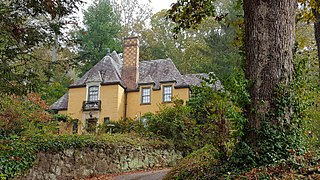
Grove Park Historic District is a national historic district located at Asheville, Buncombe County, North Carolina. The district encompasses 290 contributing buildings and 1 contributing site in a predominantly residential section Asheville. The planned suburban community was originally platted and developed in 1908-1913 and 1914. It includes representative examples of Colonial Revival, Tudor Revival, and Bungalow style dwellings. The community was laid out by noted landscape architect Chauncey Beadle. The Kimberly Amendment to Grove Park was an expansion made to the original Grove Park development in 1923. It includes the former Asheville Country Club, now the Grove Park Inn Country Club.

South King Street Historic District is a national historic district located at Morganton, Burke County, North Carolina. It encompasses 10 contributing buildings in Morganton. It includes residential, religious, and educational buildings built between about 1893 and 1939. It includes representative examples of Colonial Revival, Georgian Revival, and Gothic Revival style architecture. Notable buildings include the Grace Episcopal Church, Morganton Library, and Works Progress Administration constructed nurses' home.

Kenworth Historic District is a national historic district located at Hickory, Catawba County, North Carolina. The district encompasses 52 contributing buildings and 2 contributing structures in the planned subdivision of Kenworth in Hickory. Most of the buildings date between the early- and mid-20th century and include notable examples of Colonial Revival and Bungalow / American Craftsman style architecture. Notable buildings include the (former) Christ Lutheran Church (1926), Kenworth Elementary School (1913), Frederick O. Bock House (1923), Nichelson-Abernethy House (1922), Speas-Duval House (1921), Clyde L. Herman House, Kennedy-Setzer House (1921), and Payne-Bothwell-Scheller House (1921).
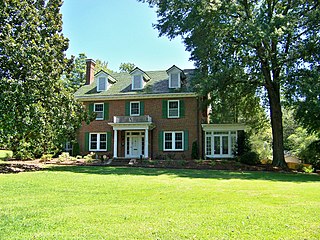
East Marion–Belvedere Park Historic District is a national historic district located at Shelby, Cleveland County, North Carolina. It encompasses 123 contributing buildings in a residential section of Shelby. The houses date between about 1921 and 1952, and include representative examples of Colonial Revival and Bungalow / American Craftsman architectural styles.
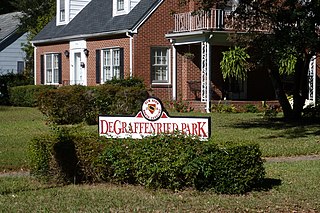
DeGraffenried Park Historic District is a national historic district located at New Bern, Craven County, North Carolina. It encompasses 86 contributing buildings and 1 contributing site in a residential section of New Bern developed between 1926 and 1956. The district is characterized by dwellings in the Colonial Revival and Tudor Revival styles. Located in the district is the site of DeGraffenried Park.
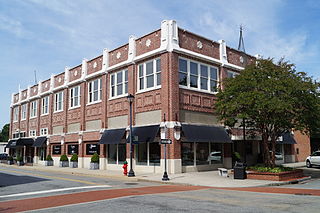
Greenville Commercial Historic District is a national historic district located at Greenville, Pitt County, North Carolina. The district encompasses 51 contributing buildings in the central business district of Greenville. It includes buildings dated from about 1914 to 1952 and notable examples of Greek Revival and Queen Anne style architecture. Located in the district and listed separately are the Pitt County Courthouse (1911) by Milburn, Heister & Company and U.S. Post Office (1913). Other notable buildings include the Proctor Hotel (1911), Montgomery Ward Department Store (1929), Dail-Hodges Building (1919), Blount Building (1924), Greenville Bank and Trust, Smith Electric Building, Greenville Municipal Building (1929) designed by Benton & Benton, Blount-Harvey Department Store (1923), White's Theater (1914), Charles Greene House (1860), and the Robert Lee Humber House (1895).
























